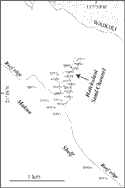
Other info:

U.S. Geological Survey
Open-File Report 03-441
Home > data > vibracores > sketches, descriptions & photographs > south coast
 |
Other info: |
|
Vibracore 38V1, south coast
Upward-fining unit of coral/algal/foraminiferal carbonate sand with pebble-size (0.5 to >5.0 cm) coral/algal clasts at base: olive to yellowish gray (5Y4/1-8/1); very poorly sorted, pebbly, fine- to very coarse-grained sand at base (sharp, scour/depositional contact) grading to poorly-sorted, fine- to medium-grained sand in upper part; massive-appearing (bioturbated); rounded to well-rounded pebbles and angular to rounded sand-size clasts; pebbly, coarse-grained lower portion composed mainly of a mix of coral fragments (38.5%), calcareous algal fragments (23.0%) and carbonate rock fragments (23.5%); upper sandy portion mainly coral fragments (27.5%), calcareous algae (26.5%) and foraminifera (23.5%); common carbonate rock fragments (4.5%), Halimeda (3.5%) and mollusks (5.5%).
|
Click either image for larger views (66 kb) 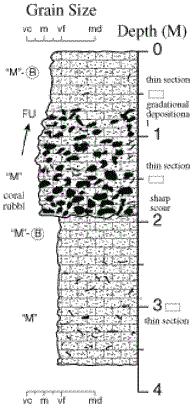 |
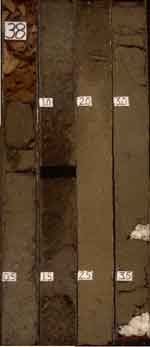 |
|
Vibracore 39V1, south coast Uniform succession of vaguely-laminated to bioturbated, fine- to medium-grained, foraminiferal/algal/coral carbonate sand: light olive to yellowish gray (5Y6/1-8/1); vague bedding indicated by oriented shell fragments; moderate sorting; sand size clasts angular to rounded; composed mainly of a mix of foraminifera (29.0-32.5%), calcareous algae (24.5-30.5%) and coral fragments (19.5-21.0%); common carbonate rock fragments (5.0-10.0%) and Halimeda (5.5-6.0%); minor echinoid fragments (1.5-2.5%) and mollusks (0.5-1.5%). |
Click either image for larger views (102 kb) 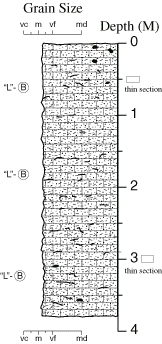 |
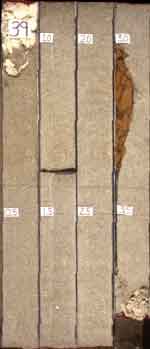 |
|
Vibracore 40V1, south coast Vaguely-laminated succession of fine- to medium- and coarse-grained, coral/algal/foraminiferal carbonate sand: light olive to yellowish gray (5Y6/1-8/1); vague bedding indicated by oriented shell fragments; coral/algal nodule rubble (3->4 cm) at base; moderate to poor sorting; sand size clasts angular to rounded; composed mainly of a mix of coral fragments (21.5-32.0%), calcareous algae (19.0-28.5%) and foraminifera (14.5-29.0%); common carbonate rock fragments (5.5-9.0%) and Halimeda (7.0-13.0%); minor echinoid fragments (1.5-2.5%) and mollusks (0.5-4.0%). |
Click either image for larger views (73 kb) 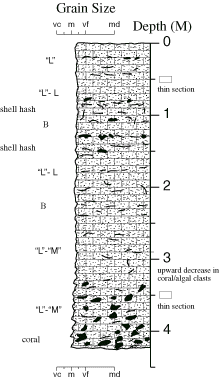 |
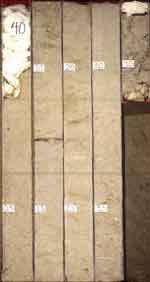 |
|
Vibracores 41V1 and 42V1, south coast Vibracore 41V1 |
Click either image for larger views (75 kb) 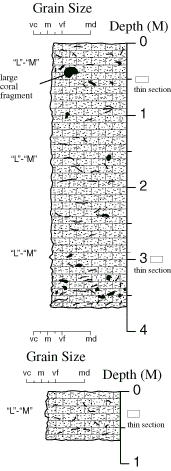 |
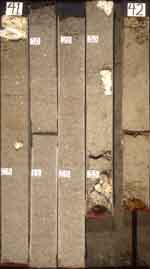 |
|
Vibracore 44V1, south coast Vaguely-laminated succession of fine- to medium-grained, algal/coral/foraminiferal carbonate sand: light olive to yellowish gray (5Y6/1-8/1); vague bedding indicated by oriented shell fragments local coral/algal fragments (2-4 cm); moderate sorting; sand size clasts angular to rounded; composed mainly of a mix of calcareous algae (31.5-31.5%), coral fragments (26.5-28.0%) and foraminifera (19.0-20.5%); common carbonate rock fragments (6.0-13.0%) and Halimeda (3.5-6.0%); minor echinoid fragments (1.0-1.5%) and mollusks (1.5%). |
Click either image for larger views (64 kb) 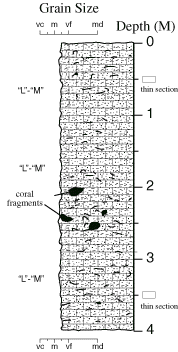 |
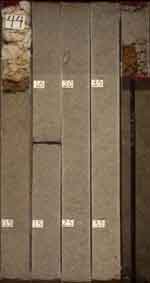 |
|
Vibracore 45V1, south coast Massive-appearing (bioturbated) succession of very fine- to very coarse-grained, coral/algal/foraminiferal carbonate sand: fining-upward in lower part of unit; light olive gray (5Y6/1); vague bedding indicated by oriented shell fragments; common large coral/algal nodule fragments; poor sorting; sand size clasts angular to rounded; composed mainly of a mix of coral fragments (34.5-36.0%), calcareous algae (18.5-27.5%) and foraminifera (15.0-26.0%); with common carbonate rock fragments (4.5%) and Halimeda (3.5-7.0%); minor volcanic rock fragments (0.5-4.5) and mollusks (2.0-4.0%); note distinct specimens of the small solitary coral Cyclosaris fragilis. Vaguely-laminated succession of very fine- to medium-grained, algal/coral/foraminiferal carbonate sand: light olive gray (5Y6/1); vague bedding indicated by oriented shell fragments; common large coral/algal nodule fragments; moderate sorting; sand size clasts angular to rounded; composed mainly of a mix of calcareous algae (28.5-30.0%), coral fragments (24.0-28.5%) and foraminifera (14.0%); common volcanic rock fragments (3.0-4.5%), carbonate rock fragments (2.5-8.5%) and Halimeda (7.5-8.5%); minor echinoid fragments (0.5-4.0%). |
Click either image for larger views 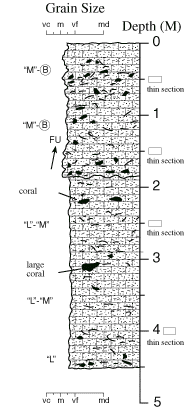 |
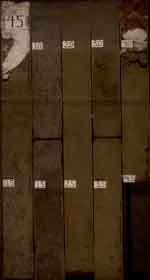 |
|
Vibracore 46V1, south coast Massive-appearing (bioturbated), slightly upward-coarsening succession of very fine- to medium-grained, algal/foraminiferal/coral carbonate sand: light olive to yellowish gray (5Y6/1-8/1); vague bedding indicated by oriented Halimeda flakes and shell fragments; moderate sorting; sand size clasts angular to rounded; composed mainly of a mix of calcareous algae (25.5-29.0%), foraminifera (26.5-27.0%); and coral fragments (11.5-19.5%); common Halimeda (8.0-11.0%) and carbonate rock fragments (4.0-4.5%); minor echinoid fragments (2.0-2.5%) and mollusks (2.0-2.5%). |
Click either image for larger views (71 kb) 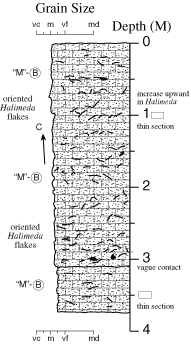 |
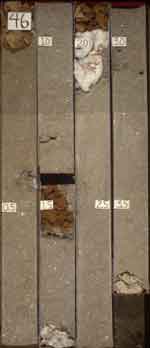 |
|
Vibracore 47V1, south coast Massive-appearing (bioturbated), fine- to medium-grained, algal/foraminiferal/coral carbonate sand: with thin pebble zone of coral fragments (3->5 cm) at 3 m; light olive to yellowish gray (5Y6/1-8/1); vague bedding indicated by oriented Halimeda flakes and shell fragments; moderate sorting; sand size clasts angular to rounded; composed mainly of a mix of calcareous algae (29.0-34.0%), foraminifera (25.0-28.0%); and coral fragments (14.0-15.5%); common Halimeda (4.0-10.0%), carbonate rock fragments (3.5-7.5%) and echinoid fragments (3.0-5.0%). |
Click either image for larger views (70 kb) 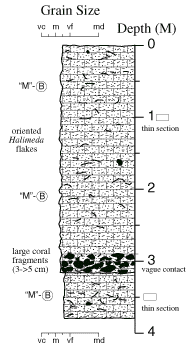 |
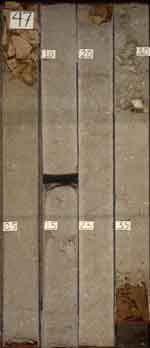 |
|
Vibracore 49V1, south coast Massive-appearing (bioturbated) succession of very fine- to medium-grained, foraminiferal/algal/coral carbonate sand: with abundant large (3-5 cm) coral clasts; light olive gray (5Y6/1); moderate to poor sorting; sand size clasts angular to rounded; composed mainly of a mix of foraminifera (29.5%), calcareous algae (26.0%) and coral fragments (18.0%); common Halimeda (6.0%), carbonate rock fragments (6.5%) and echinoid fragments (3.0%). Massive-appearing very fine- to fine-grained, algal/foraminiferal/coral carbonate sand: light olive gray (5Y6/1); well sorted; sand size clasts angular to subrounded; composed mainly of a mix of calcareous algae (26.5%), foraminifera (25.0%); and coral fragments (10.0%); common Halimeda (9.5%), carbonate rock fragments (5.5%) and echinoid fragments (3.0%). |
|
 |
|
Vibracore 51V1, south coast Massive-appearing (bioturbated) succession of very fine- to medium-grained, foraminiferal/algal carbonate sand: with local large (3-5 cm) coral clasts; light olive to yellowish gray (5Y6/1-8/1); vague bedding indicated by oriented shell fragments; moderate to poor sorting; sand size clasts angular to well rounded; composed mainly of a mix of foraminifera (50.0%) and calcareous algae (19.0%); common carbonate rock fragments (7.5%), coral fragments (6.0%) and Halimeda (5.5%). |
Click either image for larger views (66 kb) 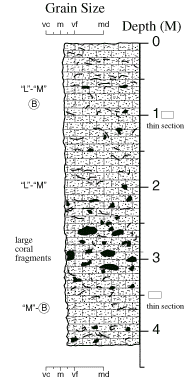 |
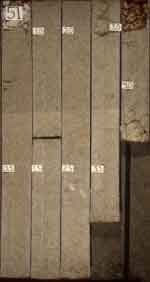 |
|
Vibracore 52V1, south coast Uniform succession of massive-appearing (bioturbated), medium- to coarse-grained, algal/foraminiferal/coral carbonate sand: light olive to yellowish gray (5Y6/1-8/1); moderate sorting; sand size clasts angular to well rounded; composed mainly of a mix of calcareous algae (28.0-32.0%), foraminifera (30.0-31.0%) and coral fragments (14.0-18.5%); common carbonate rock fragments (10.0-11.0%), Halimeda (5.0-5.5%) and mollusks (5.0-5.5%). |
Click either image for larger views 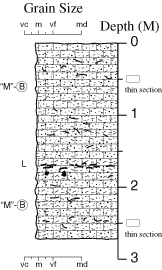 |
 |
|
Vibracore 53V1, south coast Vaguely-laminated to massive-appearing (bioturbated) succession of fine- to medium-grained, algal/foraminiferal/coral carbonate sand: light olive to yellowish gray (5Y6/1-8/1); vague bedding indicated by oriented shell fragments; moderately-well sorted; sand size clasts angular to well rounded; composed mainly of a mix of calcareous algae (30.0-36.5%) foraminifera (23.5-25.0%) and coral fragments (15.0%); common carbonate rock fragments (5.0-7.0%) and Halimeda (7.0-9.0)%; minor echinoid fragments (2.0-5.0%) and mollusks (3.0-3.5%). |
Click either image for larger views (68 kb) 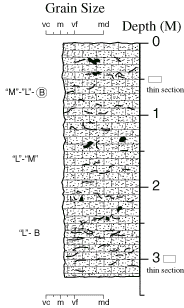 |
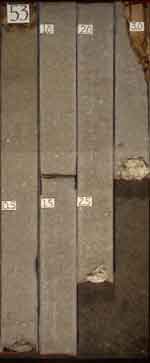 |
|
Vibracore 54V1, south coast Massive-appearing (bioturbated) very fine- to medium-grained, algal/foraminiferal/coral carbonate sand: brownish gray (5YR4/1) in lower part to yellowish gray (5Y8/1) in upper part; moderately sorted; sand size clasts angular to well rounded; composed mainly of a mix of calcareous algae (23.5-38.0%), foraminifera (18.5-27.5%) and coral fragments (17.5-19.0%); common carbonate rock fragments (5.5-8.5%) and Halimeda (3.5-4.0%); minor echinoid fragments (2.0-6.5%) and mollusks (2.0-4.0%). |
Click either image for larger views (62 kb) 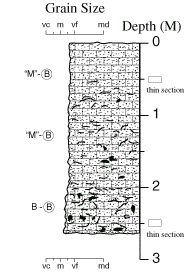 |
 |
|
Vibracore 55V1, south coast Massive-appearing (bioturbated), fine- to medium-grained, algal/foraminiferal/coral carbonate sand: light olive to yellowish gray (5Y6/1-8/1); moderately-well sorted; composed mainly of a mix of calcareous algae (25.5%) foraminifera (41.5%) and coral fragments (8.0%); common carbonaterock fragments (4.0%) and Halimeda (5.5%). Burrowed to bioturbated, pebbly, fine- to very coarse-grained, algal/coral/foraminiferal carbonate sand: light olive to yellowish gray (5Y6/1-8/1); poorly sorted; composed mainly of a mix of calcareous algae (30.0%), coral fragments (8.0%) and foraminifera (17.5%); common carbonate rock fragments (15.5%) and Halimeda (4.5%). Massive-appearing (bioturbated) to laminated, fine- to medium-grained, algal/coral/foraminiferal carbonate sand: pale yellowish brown (10YR6/2); moderately-well sorted; composed mainly of a mix of calcareous algae (27.0%), coral fragments (27.0%) and foraminifera (15.5%); common carbonate rock fragments (14.5%) and Halimeda (4.5%). |
Click either image for larger views  |
 |
|
Vibracores 56V1 and 57V1, south coast Vibracore 56V1 |
Click either image for larger views (72 kb) 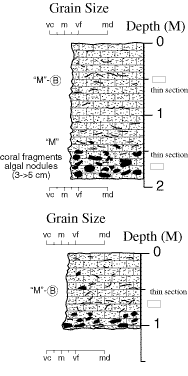 |
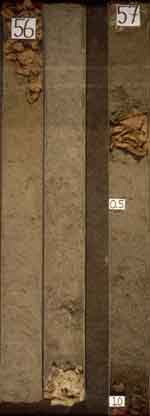 |
|
Vibracores 58V1 and 59V1, south coast Vibracore 58V1 |
Click either image for larger views (71 kb) 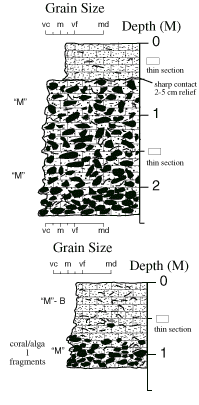 |
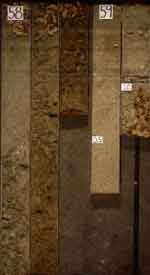 |
|
Vibracore 60V1, south coast Upward-fining, massive-appearing (bioturbated) succession; pebbly, fine- to coarse-grained carbonate sand at base grading up to fine- to medium-grained, foraminiferal/algal/coral carbonate sand: light olive to yellowish gray (5Y6/1-8/1); poorly to moderately-well sorted; sand size clasts angular to well rounded; composed mainly of a mix of abundant foraminifers (41.5-42.5%) with common calcareous algae (17.5-23.0%), coral fragments (8.0-8.5%) and Halimeda (4.0-16.0%). |
Click either image for larger views (72 kb) 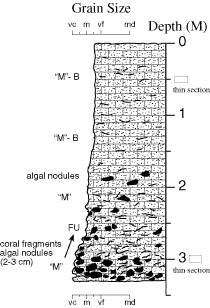 |
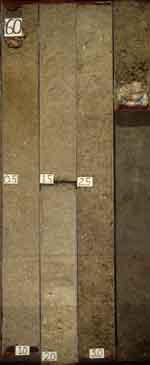 |
|
Top of page
|
http://geopubs.wr.usgs.gov/open-file/of03-441/data/vibracore/descriptions/socoast.html
For more information, please contact: Monty Hampton
Pages created and maintained by Laura Zink Torresan
last modified 15 December 2003 (cad)
USGS Privacy Statement | Disclaimer | Feedback | Accessibility
Department of the Interior U.S. Geological Survey Geologic Division
Coastal & Marine Geology Program Western Region Coastal & Marine Geology Team